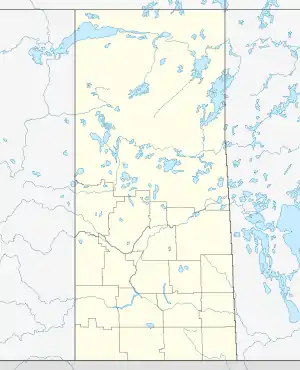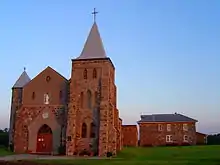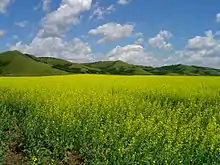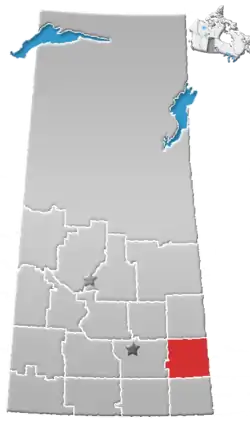Esterhazy, Saskatchewan
Esterhazy is a town in the southeastern portion of the province of Saskatchewan, Canada, located 83 km southeast of Yorkton along Highways 22 and 80. The town is located within the rural municipality of Fertile Belt No. 183.
Town of Esterhazy | |
|---|---|
Town | |
 Flag | |
| Nickname(s): Potash Capital of the World | |
 Town of Esterhazy | |
| Coordinates: 50°39′N 102°4′W | |
| Country | |
| Province | |
| Post office opened | 1903 |
| Government | |
| • Type | Town Council |
| • Mayor | Grant Forster |
| • Administrator | Mike Thorley |
| Area | |
| • Total | 4.75 km2 (1.83 sq mi) |
| Population | |
| • Total | 2,472 |
| • Density | 520.9/km2 (1,349/sq mi) |
| Time zone | UTC-6 (Central Standard Time) |
| Postal Code | S0A 0X0 |
| Area code(s) | 306 |
| Website | townofesterhazy.ca - Official Web Site |
| [1][2][3] | |
History
Esterhazy is reputed to be named for Count Paul Otto d'Esterhazy, an immigrant agent who was christened Johannes Packh, but at age 35 claimed he had "incontrovertible proof" that he was a Hungarian aristocrat of the Esterházy family. This claim was never recognized by the Esterházy family, one of the wealthiest families in Hungary.
A year after making his claim, he immigrated to Saskatchewan, south of the current location of the town of Esterhazy, and in 1886 helped settle 35 Hungarian families, founding the colony of Kaposvar, named after the Hungarian city Kaposvár.
The colony flourished, and many more immigrants settled the area as the years went by. In 1905 the town of Esterhazy was officially founded.
The area that is now the township of Esterhazy was first settled by English settlers in 1882, who founded Sumner Parish in the north. Later colonies included the Swedes to the west, Czechs to the southwest, northeast a German colony, northwest a Welsh one, and a Jewish settlement in the southeast, near Wapella, Saskatchewan.
In 1962, IMC Global (now Mosaic), a mining company, completed the shaft for a potash mine, and today the two joint mines, K1 and K2, combined produce more potash than any other mine in the world, granting Esterhazy the title of "Potash capital of the world." [4]
Historic sites



On July 8, 2009 the Esterhazy Flour Mill was designated as a national historic site of Canada, and is one of 45 Saskatchewan National Historic Sites.[5] The plaque commemorating the national historic site designation was unveiled on September 3, 2011. Garry Breitkreuz, Member of Parliament for Yorkton—Melville unveiled the plaque on behalf of Peter Kent, Canada's Minister of the Environment and Minister responsible for Parks Canada.[6]
Our Lady of Assumption Roman Catholic Church, also known as Kaposvar Church, was built in 1906-1907 by Brothers of Father Jules Pirot with Hungarian farmers hauling stones from the surrounding area. A large stone church, today it is the home of the Kaposvar Historic Site and Museum. This church is on a very well kept site, where tours of the church can be taken.[7][8]
Demographics
The town of Esterhazy had a population of 2,472 people in 2011 living in a land area of 4.74 square km.[1] The Esterhazy population centre also had a population of 2,472.[1]
Education
Esterhazy High School and P. J. Gillen School are in the Good Spirit School Division.
Students from the nearby communities of Tantallon, Yarbo and Gerald also attend school in Esterhazy.
Media
- Newspaper
- The World-Spectator community newspaper www.world-spectator.com
- Plain and Valley regional newspaper www.plainandvalley.com
- The Four-Town Journal - print and digital newspaper
- EsterhazyOnline - online newspaper
- Radio
- CJEZ-FM 99.5 - Esterhazy's first and newest local radio station. Launch date to be announced
See also
- Esterhazy - prominent Hungarian aristocratic family
- Esterhazy Airport
- Tabor Light
References
- "2011 Community Profiles". Statistics Canada. Government of Canada. Retrieved 2014-03-20.
- National Archives, Archivia Net. "Post Offices and Postmasters". Archived from the original on 2006-10-06. Retrieved 2014-03-02.
- Government of Saskatchewan, MRD Home. "Municipal Directory System". Archived from the original on 2016-01-15. Retrieved 2014-03-02.
- "Facts about Esterhazy". Town of Esterhazy. Archived from the original on 2010-01-17. Retrieved 2013-03-04.
- Reynish, Dan (2009-07-08). "Esterhazy Flour Mill declared a historic site". CBC News. Retrieved 2013-03-04.
- Norek, Audra (2011-09-03). "Harper Government Commemorates Esterhazy Flour Mill". Canada News Centre. Government of Canada. Retrieved 2013-03-04.
- "Kaposvar Historic Site" (PDF). Heritage Property Directory. Saskatchewan Ministry of Parks, Culture and Sport. Archived from the original (PDF) on 2012-10-19. Retrieved 2013-03-04.
- Adamson, Julia (16 Feb 2013). "Saskatchewan Roman Catholic Churches ~ Online Parish Registers ~ History > Esterhazy". Saskatchewan Gen Web. Ancestry.com. Retrieved 2013-03-04.
